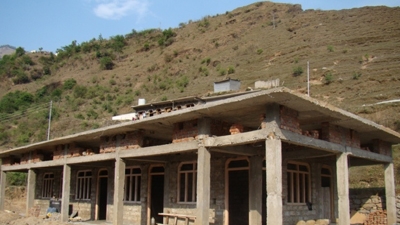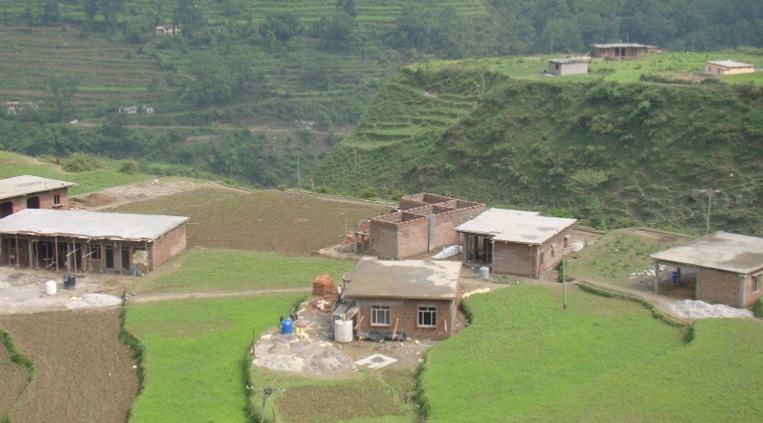PHYSICAL WORKS
Construction Progress:
The VPHEP generating scheme will be constructed primarily through two large EPC (Engineering, Procurement and Construction) contracts, one for civil works and hydro-mechanical equipment works, and the other for electro-mechanical equipment works.
Bids for the EPC contract for civil works and hydro-mechanical equipment works have been received and evaluated. However, contract award is pending the award of the second stage forest clearance by Ministry of Environment and Forests (MoEF), Government of India (GoI).
The pre-qualification process for the EPC contract for the electro-mechanical equipment, which needs to start after the civil works, has been completed. THDC will review these applications in due course.
MANAGEMENT OF SOCIAL IMPACTS
As a run-of-river project, VPHEP has comparatively limited land acquisition impacts which affect a total of 1,602 families in 18 villages. Of these families, 894 families are directly affected by loss of private land and/or structures, while the remaining 708 families are affected only by reduced access to grazing, fodder and fuel wood collection on government and van panchayat land (community held grazing and forest land).
The project will require a total of 141.57 ha of land comprising 31.639 ha of private land, 90.09 ha of government forest/grazing land, 10.3 ha of van panchayat land, and 9.54 ha of state land owned by the Public Works Department. The acquisition of private land affects seven villages, while the remaining 11 project-affected villages will lose access only to government forest/grazing and/or van panchayat land.
A total of 265 families will be resettled under the project, and of these 92 percent are families from the village Haat, where the powerhouse is to be located, had proposed their land for acquisition by THDCIL, and expressed an interest in relocating to the other side of the river, which is considered more desirable in view of the proximity to the highway, markets, schools, other land holdings of many people from Haat. Even though most of the land that the people of Haat offered was not required by the project, THDCIL agreed to this proposal in the interest of minimizing the disturbance to the village.
Land Acquisition and Resettlement & Rehabilitation (R&R): The project has acquired all the privately-owned land it will need. Out of 894 families entitled to R&R compensation, 514 families have received full or partial R&R payment. The majority of those families who have yet to receive R&R payment are from the village Haat. Disbursement of R&R compensation for them was awaiting final approval by the Government of Uttarakhand. The approval has since been given and the process is underway.
 |
| Caption: Villagers from Haat have begun building their new houses across the river |
Relocation Progress: The villagers of Haat have begun building their new houses across the river, with facilitation from THDC. As of mid-December, 51 households from Haat had received the first installment of the construction grant of Rs 1 million and, of these, 45 households had started the construction of their new houses on the left bank of the river at sites in Daswana and El Dana villages, in keeping with the agreed relocation plan for Haat.
 |
| Caption: THDC has also started the process of securing basic civic services like an access road to the highway, drinking water services, house electrification and street lighting for these new habitations. |
The Hamlet of Hatsari: When the village of Haat chose to relocate, eight families in the hamlet of Hatsari within Haat opted not to relocate. In order to limit the land acquisition impacts on Hatsari, THDCIL altered the project design and shifted the location of the switchyard from Hatsari to already acquired government forest land, and also realigned an access road. In its present design, the project requires no land from Hatsari. However, in the interest of minimizing the disturbance to these families of Hatsari during the construction period, THDCIL would prefer to facilitate their relocation, if only on a temporary basis, on terms equal to those to which the majority of the residents of Haat agreed. Negotiations with these families at Hatsari are ongoing.
Fuel & Fodder Allowance: THDC will compensate villagers for loss of access to community forestlands that it will be acquiring for the Project. The District Magistrate of Chamoli has finalized a list of 436 households from five villages, namely Math Jadetha, Guniyala, Naurakh, Gulabkoti and Batula, for this annual compensation for loss of fuel and fodder. THDC has so far disbursed Rs 4.36 million. Out of 436 households, 406 have received the first year’s compensation and 30 houses of Math have received the compensation for the second year also.
Livelihood Restoration: In order to ensure that the livelihoods of local people are not adversely affected by the project, THDCIL has drawn up an Income Restoration Plan. Under this, the Company has assisted the affected villages to form 20 co-operative societies which undertake small community infrastructure works like road repairs, building bunds and gabion walls etc. of value up to Rs 200,000.
THDCIL has also, to date, provided direct or indirect employment to 74 project affected persons either in the Company or through contractors and as sub-contractors. These opportunities for employment will increase when the major construction works start.
THDCIL is constructing a small shopping centre in Jaisal near its staff colony. Ten of the total 14 shops will be allocated to project affected families from Jaisal village.
THDCIL is also helping project affected persons get vocational training in various trades such as motor mechanics, marketing, hospitality, including a one-year diploma in hotel management from Dehradun.
Other income restoration schemes include distribution of high-yield seeds and fruit saplings and activities such as dairy development (in Guniyala village), vermicomposting, and napier grass cultivation. Self-help groups of women from Haat village are being assisted to start small knitting units. A more detailed Training Needs Assessment for individual project affected persons will soon be conducted to better design individual livelihood restoration plans.
Corporate Social Responsibility: CSR activities have been well planned with the involvement of community and are being regularly implemented. So far, community works worth Rs 40 lakh have been implemented in various project-affected villages and more worth around Rs 51.5 lakh are under implementation. These include works like building pathways, ropeways and drinking water schemes for these remote mountain villages. Further, the Company is providing scholarhsips to meritorious students from these villages to help them build better futures for themselves.
Grievance Redress Committee (GRC): The GRC established under the project is working well to address issues referred to it by project-affected people (PAPs). So far, 13 formal and 36 informal meetings of the GRC have taken place. In response to a suggestion from project-affected people the GRC will occasionally hold its meetings in project-affected villages rather than always in THDCIL’s project office.
Monitoring and evaluation (M&E): THDCIL has engaged an M&E consultant team whose quarterly reports will be available in the VPHEP Project Information Centre and on the THDC website.
MANAGEMENT OF ENVIRONMENT IMPACTS
THDCIL has posted three environmental specialists at site to be responsible for the implementation of the Environment Management Plan, and the dedicated Social and Environmental cell headed by a Senior Manager is fully operational at site.
Muck Disposal: THDCIL has made arrangements for the effective disposal of the debris that will be generated by the excavation works. It has identified four sites and, after approval from the Uttarakhand Pollution Control Board, designated them as the areas where the muck will be delivered. The contract document for the civil works will mandate the contractor to dump the debris in only these areas and to build strong retaining walls to ensure that no muck falls into the river.
Catchment Area Treatment Plan: The Company has budgeted Rs 47 lakh for improving and restoring the catchment area; this important activity will be implemented by the State Forest Department on the basis of funds provided by THDCIL. The Company will liaise closely with the Department on a detailed plan for implementation and monitoring of the CAT Plan.
ISO Certification: THDC has worked to improve its systems and acquire the ISO 9001:2008 certification on Quality Management Systems and also the ISO: 140001:2004 certification on Environmental Management Systems. These certifications are valid until March 2015.
Archeological Management: The Company has engaged the Archaeological Survey of India (ASI), Dehradun, to help lead the archeological preservation and restoration management of the Laxmi Narayan temple at Haat. The team from ASI will visit the site shortly to begin the conservation works.
Monitoring: THDC proposes to introduce third-party monitoring of the environmental management of the Project. The Indian Council for Forestry Research and Education (ICFRE), Dehradun, has been identified for monitoring the CAT Plan works and another agency will be identified to monitor the other elements of the EMP.
THDCIL is preparing a consolidated environmental monitoring format based on the EMP and on activities mandated by (a) the environment and forest clearances, (b) the conditions of the Pollution Control Board’s NOC to the project, (c) actions agreed with community during public hearings of the project, (d) ISO 14001 requirements; and (e) any other requirements identified in the bid documents.

